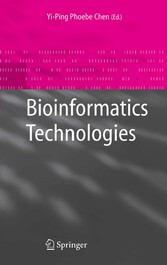Suchen und Finden
Preface
5
Contents
10
1 Introduction to Bioinformatics
15
1.1 Introduction
15
1.2 Needs of Bioinformatics Technologies
16
1.3 An Overview of Bioinformatics Technologies
19
1.4 A Brief Discussion on the Chapters
22
References
26
2 Overview of Structural Bioinformatics
29
2.1 Introduction
29
2.2 Organization of Structural Bioinformatics
31
2.3 Primary Resource: Protein Data Bank
32
2.4 Secondary Resources and Applications
36
2.5 Using Structural Bioinformatics Approaches in Drug Design
51
2.6 The Future
53
References
54
3 Database Warehousing in Bioinformatics
59
3.1 Introduction
59
3.2 Bioinformatics Data
62
3.3 Transforming Data to Knowledge
65
3.4 Data Warehousing
68
3.5 Data Warehouse Architecture
70
3.6 Data Quality
72
3.7 Concluding Remarks
74
References
75
4 Data Mining for Bioinformatics
77
4.1 Introduction
77
4.2 Biomedical Data Analysis
78
4.3 DNA Data Analysis
85
4.4 Protein Data Analysis
106
References
123
5 Machine Learning in Bioinformatics
131
5.1 Introduction
131
5.2 Artificial Neural Network
134
5.3 Neural Network Architectures and Applications
142
5.4 Genetic Algorithm
149
5.5 Fuzzy System
155
References
161
6 Systems Biotechnology: a New Paradigm in Biotechnology Development
169
6.1 Introduction
169
6.2 Why Systems Biotechnology?
170
6.3 Tools for Systems Biotechnology
172
6.4 Integrative Approaches
178
6.5 In Silico Modeling and Simulation of Cellular Processes
180
6.6 Conclusion
184
References
185
7 Computational Modeling of Biological Processes with Petri Net- Based Architecture
193
7.1 Introduction
193
7.2 Hybrid Petri Net and Hybrid Dynamic Net
197
7.3 Hybrid Functional Petri Net
204
7.4 Hybrid Functional Petri Net with Extension
205
7.5 Modeling of Biological Processes with HFPNe
212
7.6 Related Works with HFPNe
225
7.7 Genomic Object Net: GON
226
7.8 Visualizer
238
7.9 BPE
247
7.10 Conclusion
250
References
250
8 Biological Sequence Assembly and Alignment
257
8.1 Introduction
257
8.2 Large-Scale Sequence Assembly
259
8.3 Large-Scale Pairwise Sequence Alignment
268
8.4 Large-Scale Multiple Sequence Alignment
271
8.5 Load Balancing and Communication Overhead
273
8.6 Conclusion
273
References
274
9 Modeling for Bioinformatics
277
9.1 Introduction
277
9.2 Hidden Markov Modeling for Biological Data Analysis
278
9.3 Comparative Modeling
295
9.4 Probabilistic Modeling
301
9.5 Molecular Modeling
304
References
311
10 Pattern Matching for Motifs
313
10.1 Introduction
313
10.2 Gene Regulation
315
10.3 Motif Recognition
317
10.4 Motif Detection Strategies
319
10.5 Single Gene, Multi-species Approach
321
10.6 Multi-genes, Multi-species Approach
323
10.7 Summary
323
References
324
11 Visualization and Fractal Analysis of Biological Sequences
327
11.1 Introduction
327
11.2 Fractal Analysis
331
11.3 DNA Walk Models
337
11.4 Chaos Game Representation of Biological Sequences
339
11.5 Two-Dimensional Portrait Representation of DNA Sequences
344
11.6 One-Dimensional Measure Representation of Biological Sequences
349
References
362
12 Microarray Data Analysis
367
12.1 Introduction
367
12.2 Microarray Technology for Genome Expression Study
368
12.3 Image Analysis for Data Extraction
370
12.4 Data Analysis for Pattern Discovery
377
References
398
Index
403
Alle Preise verstehen sich inklusive der gesetzlichen MwSt.








